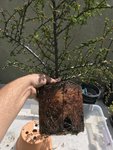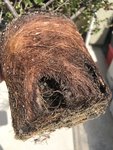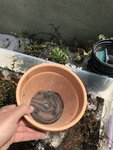SilverShoe99
Mame
Sup nuts.
I've got a couple Ladder Leaf Cotoneasters that I picked up on a lark from a nursery a few months back. As I haven't yet got a plan for them, they've just been sitting over in the corner of the yard doing their thing. I've noticed that they haven't grown as vigorously as I'd have expected them to this spring, so I pulled them out of their nursery cans and found.....this.




This is just one of the two, but they both look the same - totally rootbound, major air pockets in the root ball, and slugs living in the air pockets.
Ideally, I'd like to reduce these rootballs and get these into some bonsai soil, but I'm inclined to think it's probably too late into spring to do that safely. Alternatively, I was wondering if I might be able to safely reduce the rootball by 1/3 to 1/2, tease out the outer circling roots, and slip pot it into a bonsai soil/training pot situation.
All advice is welcome. Thanks!
I've got a couple Ladder Leaf Cotoneasters that I picked up on a lark from a nursery a few months back. As I haven't yet got a plan for them, they've just been sitting over in the corner of the yard doing their thing. I've noticed that they haven't grown as vigorously as I'd have expected them to this spring, so I pulled them out of their nursery cans and found.....this.




This is just one of the two, but they both look the same - totally rootbound, major air pockets in the root ball, and slugs living in the air pockets.
Ideally, I'd like to reduce these rootballs and get these into some bonsai soil, but I'm inclined to think it's probably too late into spring to do that safely. Alternatively, I was wondering if I might be able to safely reduce the rootball by 1/3 to 1/2, tease out the outer circling roots, and slip pot it into a bonsai soil/training pot situation.
All advice is welcome. Thanks!










